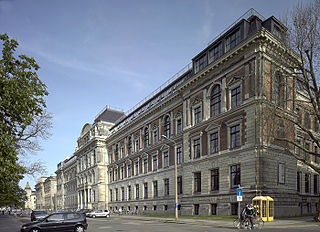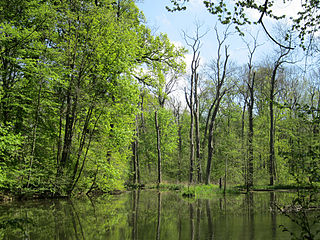
Leipzig is the most populous city in the German state of Saxony. Leipzig's population of 605,407 inhabitants as of 2021 places the city as Germany's eighth most populous, as well as the second most populous city in the area of the former East Germany after (East) Berlin. Together with Halle (Saale), the city forms the polycentric Leipzig-Halle Conurbation. Between the two cities lies Leipzig/Halle Airport.

The Wave-Gotik-Treffen is an annual world festival for "dark" music and "dark culture" in Leipzig, Germany. 150+ bands and artists from various backgrounds play at several venues throughout the city over four days on Whitsuntide. The festival also features multiple all-night dance club parties, several fairs with medieval, gothic, and related merchandise, a variety of cultural exhibitions and performances, large themed picnics, and a number of unofficial fringe events.

The Central German Metropolitan Region is one of the officially established metropolitan regions in Germany. It is centered on the major cities of Leipzig and Halle, extending over Central German parts of the states of Saxony-Anhalt, Thuringia and Saxony. The Central German metropolitan region is the only one located entirely within the former East Germany. The "region" is not actually a metropolitan area in the geographic sense of the word as an agglomeration of nearby urban areas, rather it is a registered association, the Europäische Metropolregion Mitteldeutschland e.V. whose membership is composed of towns, cities, municipalities, and companies, colleges and chambers of commerce in the central German geographic area, whose representatives vote upon new members. For example, Jena joined the Metropolitan Region in 2009. The registered association owns the management company Metropolregion Mitteldeutschland Management GmbH. As such it forms a planning and marketing framework for the region while retaining the legal independence of its members.

The German National Library is the central archival library and national bibliographic centre for the Federal Republic of Germany. It is one of the largest libraries in the world. Its task is to collect, permanently archive, comprehensively document and record bibliographically all German and German-language publications since 1913, foreign publications about Germany, translations of German works, and the works of German-speaking emigrants published abroad between 1933 and 1945, and to make them available to the public. The DNB is also responsible for the Deutsche Nationalbibliografie and several special collections like the Deutsches Exilarchiv 1933–1945, Anne-Frank-Shoah-Bibliothek and the Deutsches Buch- und Schriftmuseum. The German National Library maintains co-operative external relations on a national and international level. For example, it is the leading partner in developing and maintaining bibliographic rules and standards in Germany and plays a significant role in the development of international library standards. The cooperation with publishers has been regulated by law since 1935 for the Deutsche Bücherei Leipzig and since 1969 for the Deutsche Bibliothek Frankfurt.

Bruno-Plache-Stadion is a multi-use stadium in Leipzig, Germany. It is currently used mostly for football matches and is the home stadium of 1. FC Lokomotive Leipzig. Fans only call it "das Bruno". The stadium has a capacity of 15,600 people, but it is only accredited for 7,000 people at the moment.

The Museum der bildenden Künste is a museum in Leipzig, Saxony, Germany. It covers artworks from the Late Middle Ages to Modernity.

Gewandhaus is a concert hall in Leipzig, the home of the Leipzig Gewandhaus Orchestra. Today's hall is the third to bear this name; like the second, it is noted for its fine acoustics.

The Max Planck Institute for Human Cognitive and Brain Sciences is located in Leipzig, Germany. The institute was founded in 2004 by a merger between the former Max Planck Institute of Cognitive Neuroscience in Leipzig and the Max Planck Institute for Psychological Research in Munich. It is one of 86 institutes in the Max Planck Society.

The Palaeontological Museum in Germany, is a German national natural history museum located in the city of Munich, Bavaria. It is associated with the Ludwig-Maximilians-Universität. It has a large collection of fossils of animals and plants such as Mesozoic reptiles, early elephants and saber-toothed cats. The paleontological and geological institute which houses the museum is formally called the Bavarian State Collection for Palaeontology and Geology, which itself is one of several institutions which make up the Bavarian Natural History Collections.

The Bavarian State Collection of Zoology or ZSM is a major German research institution for zoological systematics in Munich. It has over 20 million zoological specimens. It is one of the largest natural history collections in the world. The sections are Entomology, Invertebrates and Vertebrates. The history of the museum is outlined on the museum's home page together with a biography of Johann Baptist von Spix the first curator of zoology.

The Augustusplatz is a square located at the east end of the city centre of Leipzig. It is the city's largest square and one of the largest squares in Europe. It is also part of the city's inner-city ring-road and a central hub for its tram network.

The Leipzig tramway network is a network of tramways which together with the S-Bahn Mitteldeutschland forms the backbone of the public transport system in Leipzig, a city in the federal state of Saxony, Germany. Opened in 1872, the network has been operated since 1938 by Leipziger Verkehrsbetriebe (LVB), and is integrated in the Mitteldeutscher Verkehrsverbund (MDV).

The Hochschule für Grafik und Buchkunst (HGB) or Academy of Fine Arts Leipzig is one of the oldest art schools in Germany, dating back to 1764. The school has four colleges specializing in fine arts, graphic design, photography and new media art.

The Museum of Antiquities of the University of Leipzig is a collection of antiquities in Leipzig, Germany.

The Leipzig Museum of Ethnography is a large ethnographic museum in Leipzig, Germany, also known as the Grassi Museum of Ethnology. Today it is part of the Grassi Museum, an institution which also includes the Museum of Applied Arts and the Museum of Musical Instruments, based in a large building on the Johannisplatz.

The Grassi Museum is a building complex in Leipzig, home to three museums: the Ethnography Museum, Musical Instruments Museum, and Applied Arts Museum.

The Bach-Archiv Leipzig or Bach-Archiv is an institution for the documentation and research of the life and work of Johann Sebastian Bach. The Bach-Archiv also researches the Bach family, especially their music. Based in Leipzig, the city where Bach lived from 1723 until his death, the Archiv is recognised by the German government as a "cultural beacon" of national importance. Since 2008 the Bach-Archiv has been part of the University of Leipzig.

Leipzig Riverside Forest is one of the largest lowland Riparian forests in Central Europe, which lies mostly within the city limits of Leipzig city in Germany. The natural reserve is partially covered with hardwood forest and contains a large variety of endangered species.

The German Museum of Books and Writing in Leipzig, Germany, founded in 1884 as Deutsches Buchgewerbe-Museum, is the world's oldest museum of its kind, dedicated to collecting and preserving objects and documents as well as literature connected with the history of books, including paper, printing techniques, the art of illustration, and bookbinding. The museum is housed in a modern €60 million annex to the German National Library in Leipzig built in 2011.



















